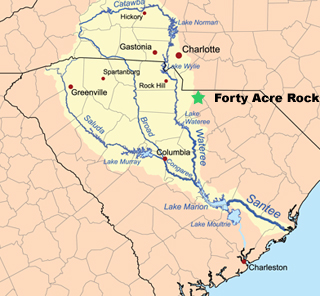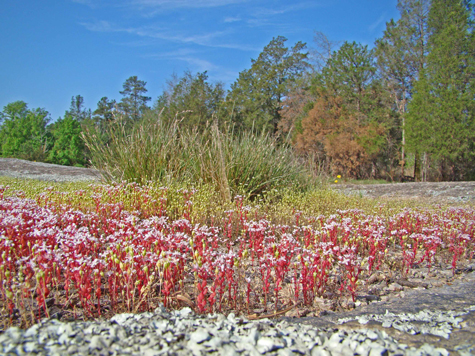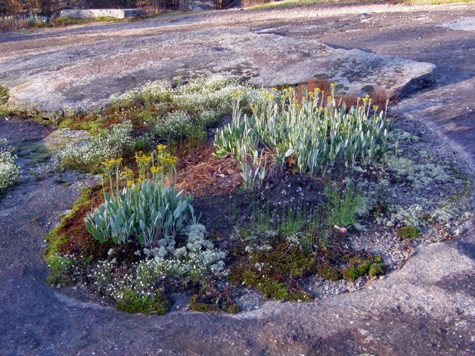Human Flower Project
Elves of South Carolina
A collision 300 million years ago created the peculiar but ideal environment for many now-rare plants. Conserving the habitat for elves takes a giant effort.

Forty Acre Rock: A rare stone outcropping in South
Carolina’s Lynches River Valley is home to rarer flora
Map: Wiki/Human Flower Project
Natural conservation requires supernatural forces. The demands of economic development encroach on speechless plants. And as the stew boils in debate over global warming (now euphemized as “climate change”), armadillos root northwards and polar bears hunt for ice.
In South Carolina, “supernatural” takes the form of social organization, i.e. work—the combined efforts of the legal experts, naturalists, conservation volunteers and and state officials. How do we know? An elf-advocate told us.
Earlier this week Lindsay Pettus, president of the Katawba Valley Land Trust, dropped some provocative photos through our inbox – plants the likes of which we’d never seen and stone outcroppings reminiscent of Enchanted Rock.
Lindsay is an expert at curiosity-fishing, and as usual we took the bait. What were these shiny red and white flowers, or were they actually jelly beans on cinnamon sticks?

Elf Orpine (Sedum smalli) at Forty Acre Rock wildlife preserve
Lancaster County, South Carolina
Photo: David Youngblood
The answer came, from naturalist Austin Jenkins, one of Lindsay’s many partners in conservation:
“The first photo is a picture of Elf Orpine, or Sedum smallii. It is a little succulent that grows in the granitic pools of Forty Acre Rock,” a fragile and rare wildlife area in Lancaster County, South Carolina.
“Plants such as these take advantage of spring rains that fill the pools for a brief period,” Austin explained. “All growth, flowering, and seed production happens fast. Then the seeds sit there for several months in the very hot, dry pool, until germination occurs later in fall/winter, when rains fill the pools back up.”
A bit of background, deep background: “The granite at Forty Acre Rock formed when the continents collided 300 million years ago to form Pangea. The collision caused magma to well up underneath the surface of the earth. It did not surface, as in a volcano, but rather cooled and solidified underneath the earth. Over time it was exposed through the process of erosion. On flat areas of the rock, where weakly acidic rainwater can collect and eat away at the rock, the rock slowly forms depressions.”
And these shallow depressions are prime habitat for floral sprites: “They first become colonized by Elf Orpine and later by other beautiful plants, mosses, and lichens such as those shown here:

Naturalist Austin Jenkins identified: “Yellow is Woolly Ragwort and white is Sandwort”
Forty Acre Rock, SC
Photo: Bill Stokes
“Because of this story and the rarity of such outcrops, the plants that grow here are rare. Many are listed federally as threatened or endangered.”
Forty Acre Rock has been protected through the efforts of the Nature Conservancy and South Carolina Department of Natural Resources. Austin writes, “Lindsay played an important role in this effort,” and not just by curiosity pricking. “Over time Katawba Valley Land Trust got involved and has added to the protected acreage through conservation easements and purchase of land. The area now boasts nearly 3000 acres of contiguous protected land, most of which is available to the public so that they can experience the splendor of the rock and the beauty of her surrounding woodlands….Come see us sometime.”
A super invitation relayed with Southern grace! Thank you, Austin and Lindsay, and to all your partners, giant and small, in the delicate work of conservation.
Comments
I came here expecting little people, but this was way better. I love little natural gardens like this. Iceland has lots of little spots like this, too.


Nice composition in the photograph by Bill Stokes. Very much enjoyed this post, Julie.